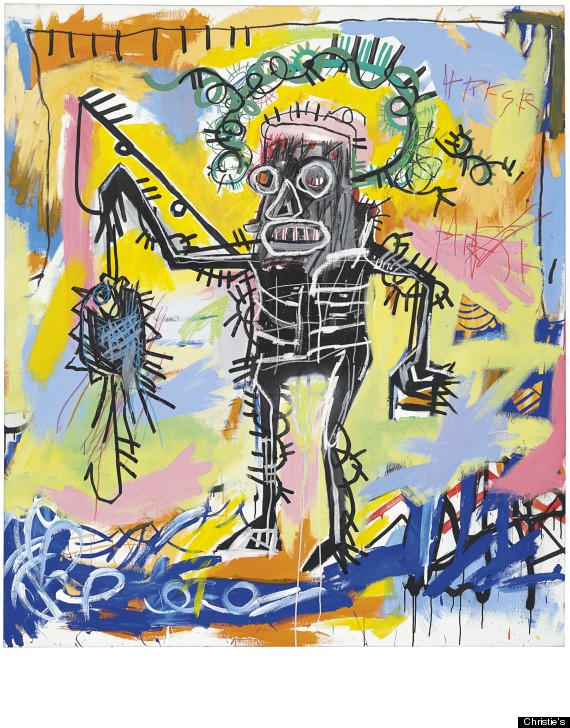"This is a song for the genius child.
Sing it softly, for the song is wild.
Sing it softly as ever you can -
Lest the song get out of hand.
Nobody loves a genius child.
Can you love an eagle,
Tame or wild?
Can you love an eagle,
Wild or tame?
Can you love a monster
Of frightening name?
Nobody loves a genius child.
Kill him - and let his soul run wild."
--Langston Hughes

There's a cemetery in Brooklyn bearing the name of a gone-too-soon visionary of his time. Toward the end of 1988, Gerard Basquiat held a closed casket service for his 27 year old son. Only a handful of the dead artist's friends were invited to the ceremony , but word had spread to greedy art dealers. They were the carrion eaters, ready to pick and pry on the 2,000 plus pieces of art left behind. Jean-Michel Basquiat was born at the tail end of 1960. As a child, he started out scribbling on the scraps of paper his father brought home from his accounting job. By age 17, Jean was making comics with his friend Al Diaz and skipping class. Their famed pseudonym "SAMO" sprang forth from a school assignment and became the beginning of the underground graffiti movement in New York. Odd phrases were punctuated with a copyright symbol and found on scattered buildings around the downtown Manhattan. This was the beginning of Jean's entrance into the art world.

Jean grew up educated in various private schools before dropping out in 1978. He was multilingual with his parents' languages: French, English, Creole, and Spanish. After his parents divorced, he resided with his father while his beloved mother lived between mental health facilities. After he quit school, it was the beginning of a life long struggle to regain his father's respect for his chosen "field of study". His first big break came in 1980 with the groundbreaking exhibition entitled The Times Square Show. The rich and brutal history of African Americans as well as the present issues he witnessed as a young black artist living in Manhattan were used as fuel for his artistic purpose. He borrowed visual cues from artists like Cy Twombly and William de Kooning.
 |
| Twombly |
With the growing pressure on the New York art scene, Jean-Michel was faced with a dilemma. He was "outsider art" suddenly on the forefront of "high art" and for a blossoming artist, the expectation set upon his shoulders was crushing. He had never been rich before and often just hid thousands of dollars between books, under mattresses, and in any nook he could find. Who to trust and what to do with himself added to the mounting issues. On top of everything else, he had an evolving drug addiction. In high school, it was no secret that Jean smoked marijuana with Al Diaz. Later in his art career, he claimed that heroin helped him focus on making more paintings. It can be argued that pressure from his dealers drove him to take attention enhancing drugs, but the unfortunate end result remains the same. He hopped on a rocket of fame, and in August of 1988 it exploded under him. A fatal heroin overdose brought an end to Jean-Michel Basquiat's life.
When he was alive and thriving, Jean found himself in the company of legendary greats in the circuit of underground clubs. People like Andy Warhol and Keith Haring had very close companionship with the neo-expressionist. The singer Debbie Harry was the first person he ever sold a painting to.
Jean's work ethic comes as no surprise given the excessive amounts of work he produced in his short career. He would go out and cavort in the hallmark underground 80's clubs (CBGB, Mudd club, Club 57, Studio 54, etc) and then isolate himself for days at a time to paint and "makeup for lost time." People who hung around to watch him paint say that he allowed himself to be completely overloaded with information as he made work. Books, television, and music. Grey's anatomy, the news, and Charlie Parker. All of it filtered into his head and ended up as output onto a canvas in the form of acrylic paint or oil stick. As his drug addiction grew worse, his paintings became sparse and barren.
 |
| Keith and Jean |
 |
| William Burroughs, Jean, Debbie |
Jean's work ethic comes as no surprise given the excessive amounts of work he produced in his short career. He would go out and cavort in the hallmark underground 80's clubs (CBGB, Mudd club, Club 57, Studio 54, etc) and then isolate himself for days at a time to paint and "makeup for lost time." People who hung around to watch him paint say that he allowed himself to be completely overloaded with information as he made work. Books, television, and music. Grey's anatomy, the news, and Charlie Parker. All of it filtered into his head and ended up as output onto a canvas in the form of acrylic paint or oil stick. As his drug addiction grew worse, his paintings became sparse and barren.
 |
| 1988 |
 |
| 1981 |
